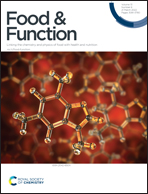Bioactivity-guided isolation of the major anthocyanin from Lycium ruthenicum Murr. fruit and its antioxidant activity and neuroprotective effects in vitro and in vivo†
Abstract
Lycium ruthenicum Murr. fruit (LRF) is an edible berry known for its rich anthocyanin content. Our previous study has shown that LRF-derived anthocyanins have neuroprotective effects in rats, which may be due to their effective antioxidant activity. Therefore, this study performed online HPLC-DPPH screening as a bioactivity-guided method for the preparative separation of anthocyanins from LRF. Finally, the main fraction was isolated and identified as petunidin-3,5-O-diglucoside (Pn3G5G). Pn3G5G exhibited strong antioxidant capacity during DPPH and ABTS free radical scavenge assays. Furthermore, Pn3G5G exhibited protective effects on Nε-carboxymethyllysine (CML)-treated Neuro-2a cells by enhancing cell viability in a dose-dependent manner. CML-induced apoptosis was also reduced by Pn3G5G potentially by suppressing oxidative stress and inflammation. More importantly, Pn3G5G significantly improved cognitive impairment, neuroinflammation and neuronal apoptosis in D-galactose-induced aging mice. The result suggests the development of Pn3G5G as a healthcare product or a potent dietary supplement with antioxidant and neuroprotective effects.

- This article is part of the themed collection: Food & Function HOT Articles 2022


 Please wait while we load your content...
Please wait while we load your content...